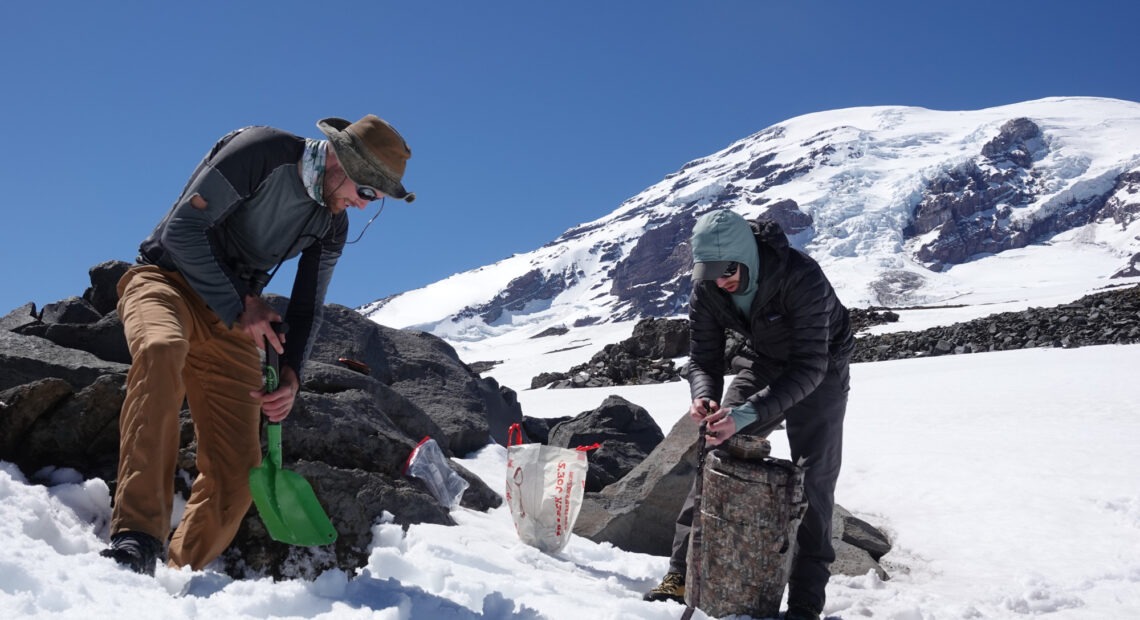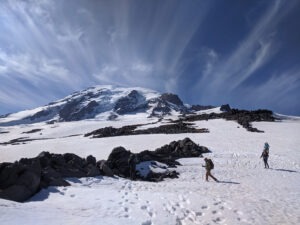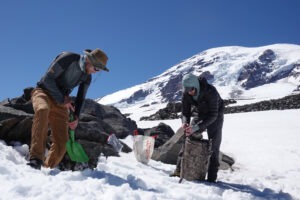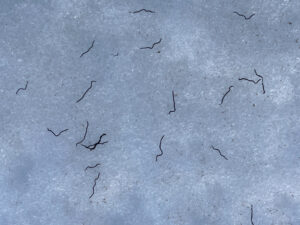
The Mysterious Return Of Glacier Ice Worms On Mount Rainier
LISTEN
BY NELL GREENFIELDBOYCE
High up on Mount Rainier in Washington, there’s a stunning view of the other white-capped peaks in the Cascade Range. But Scott Hotaling is looking down toward his feet, studying the snow-covered ground.
“It’s happening,” he says, gesturing across Paradise Glacier.
Small black flecks suddenly appear on the previously blank expanse of white. The glacier’s surface quickly transforms as more and more tiny black creatures emerge. The ice worms have returned, snaking in between ice crystals and shimmering in the sun.
These thread-like worms, each only about an inch long, wiggle up en masse in the summertime, late in the afternoon, to do — what? Scientists don’t know. It’s just one of many mysteries about these worms, which have barely been studied, even though they’re the most abundant critter living up there in the snow and ice.
Billions and billions of inch-long black creatures
“There are so many,” says Hotaling, a researcher at Washington State University. An estimated 5 billion ice worms can live in a single glacier.
“From where we’re standing right now, I can see, five, six, 10 glaciers,” he says. “And if every one hosts that density of ice worms? That is just a massive amount of biomass in a place that is generally biomass-poor.”

Ice worm researchers Scott Hotaling and Peter Wimberger led a trip to study life on the glaciers of Mount Rainier in June. For a long time, Hotaling says, biologists have written off high-altitude glaciers as sterile, lifeless places. But that’s no longer. CREDIT: Jordan Boersma
For a long time, he says, biologists have written off high-altitude glaciers such as these as basically sterile, lifeless places. Ice worms, however, show that this fragile environment — where the glaciers are vulnerable to climate change and are retreating — is potentially far more complicated.
“If you were going to put a biological mascot on glaciers of the Northwest,” Hotaling says, “it’s an ice worm.”
And yet, with the possible exception of the annual Cordova Iceworm Festival in Alaska, these bizarre worms have generally been either ignored or treated as a mere curiosity.
The National Park Service’s visitors center near Paradise Glacier, for example, has a nice display on alpine wildlife, Hotaling says, “and there is somehow nothing about ice worms. And it is a source of frustration for me.”
He admits that it bothers “probably no one else that comes here.” Many people who hike, ski or work on these mountains have never seen an ice worm despite their abundance, partly because the beasts only come to the surface at certain times of the year, at certain times of day.
”Damn it, they’re real!”
“They’re very obvious once you notice them, but it’s so beyond your expectation, when you’re in a glacier environment, that there will be worms,” Hotaling says.
His colleague Peter Wimberger of the University of Puget Sound says that he got interested in the worms years ago when a student said he wanted to study them. Wimberger thought the guy was pulling his leg and that it was some kind of prank. “He realized I didn’t believe him,” Wimberger says, “and all of a sudden he pulled out this little, small stack of papers and he said, ‘Damn it, they’re real!’ ”
The stack of scientific papers was small because only a half-dozen or so researchers have ever studied the worms, Hotaling says.
They thrive in a glacier but die if they freeze
No one knows how these worms survive the harsh winters, or how far they burrow down into the snow. Hotaling thinks that at times they likely live under 30 feet or more of snow, down where the yearly seasonal snow meets the older snow of the glacier.
Winter may be the best season for them and a time when they can increase their energy stores, Hotaling says, because the worms are fatter when they first come out, early in the summer, than they are later on.
The worms are thought to eat snow algae and bacteria, but they may not need much. “I’ve kept them in my fridge, in my home, for physiology experiments, for a year or more, without adding anything to their system, and they’re fine,” Hotaling says.

Though they’re called ice worms, the creatures Hotaling (right) and his colleagues study on the glaciers of Mount Rainier can’t handle the slightest bit of freezing. If temperatures dip even slightly below zero degrees Celsius (32 degrees Fahrenheit), Hotaling says, the worms die. CREDIT: Peter Wimberger
Actually, though, he notes that he’s not sure if those particular worms survived the year, or if they reproduced themselves. That’s because ice worm reproduction is also a big black box.
“Early in the summer you tend to see more smaller ice worms, suggesting that at some point before that, their little eggs hatched and baby ice worms popped out,” Wimberger says, “but we don’t know.”
What is clear, from lab tests, is something pretty surprising for an animal that has “ice” in its name: “They can’t handle even the slightest bit of freezing,” Hotaling says.
The worms may live at zero degrees Celsius (32 degrees Fahrenheit), but if temperatures dip even slightly below that, he says, the worms die.
Ultraviolet light doesn’t faze them
Other tests, meanwhile, show that the worms shrug off shockingly high levels of harsh ultraviolet light, according to Hotaling. Which is a good thing for them, because the summer sun on the treeless, snow-covered mountainside can be intense. Whatever drives them up to the surface, they seem to wait until the later hours in the day when the sun isn’t as unforgiving.
“I actually think they are coming looking for the sun a bit,” Hotaling says, “because they want to have some of that heat energy to drive their biochemical reactions.”
Hotaling, Wimberger and a grad student — Jordan Boersma — have worked together to set up wildlife cameras around Paradise Glacier this summer. They want to understand to what degree wildlife uses these glaciers — and rely on ice worms for food.
Already, the researchers have spotted birds chowing down on ice worms. Those known to peck at worms include gray-crowned rosy finches, American pipits, common ravens, horned larks, semipalmated plovers and snow buntings.
Boersma says they want to know “if alpine nesting birds use them to provision their nestlings and if that’s an essential part of their life history.”

The worms shrug off shockingly high levels of harsh ultraviolet light, according to Hotaling, which is a good thing, because the summer sun on the treeless, snow-covered mountainside can be intense. CREDIT: Scott Hotaling
The birds may have an impact on the ice worms’ natural history, too. Genetic research shows that ice worms may have traveled long distance from Alaska to Vancouver Island, perhaps by sticking onto the feet of migrating birds and hitching a ride.
So many basic questions remain unanswered. “There are more mysteries than there are solved things with ice worms,” Hotaling says.
He even wonders if ice worms might affect how fast a glacier melts, because their black bodies must absorb heat. It’s known that the presence of dark-colored glacier algae can speed melting, and ice worms clearly change the surface of a glacier.
“What goes away when a mountain glacier is lost? I don’t think we have a good answer to that question,” Hotaling says. “Ice worms are an extraordinary example of a bit of biodiversity on our planet that most people don’t know about. And in this case, of Seattle and the Northwest, it’s in the backyard of millions of people.”
9(MDAyOTk4OTc0MDEyNzcxNDIzMTZjM2E3Zg004))















